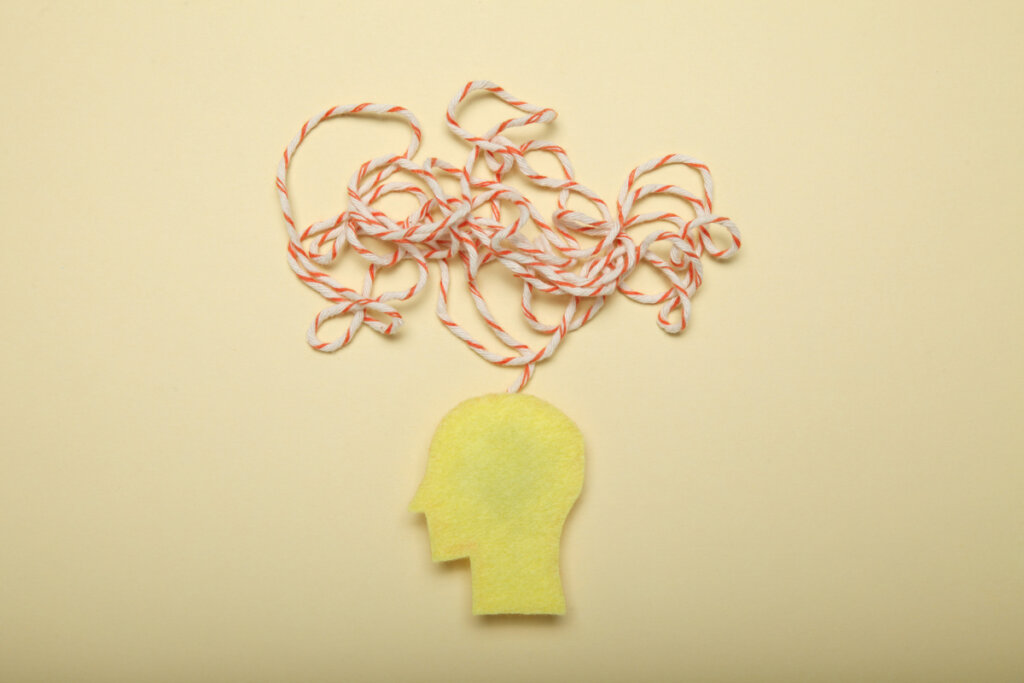Seven of the Differences Between Compulsions and Obsessions


Written and verified by the psychologist Valeria Sabater
The differences between compulsions and obsessions outline the clinical profile of obsessive-compulsive disorder (OCD). This disorder ranks fourth among the most frequent mental disorders in the world, according to a publication in the journal, Medicentro Electrónica.
OCD is a complex and sometimes serious condition, as it alters the sufferer’s way of thinking and behavior. Fortunately, there are effective strategies available to treat it.
Obsessive thoughts and the compulsion itself and its associated rituals are phenomena that the patient can’t control. There are several types of OCD. They all involve impulsive behaviors that significantly affect the sufferer’s life. Indeed, they cause high levels of anguish and anxiety. Here, you can learn about the particularities of each dimension.
OCD is a chronic disorder that can be treated through specialized therapies.
Differences between compulsions and obsessions
An OCD sufferer may experience obsessive thoughts which might be accompanied, or not, by compulsions. It’s common for patients to experience these symptoms for a long time before being diagnosed.
Research conducted in 2021 and published in the journal, PLOS ONE states that finding the right therapy can take up to 17 years. This is a long time. Hence the relevance of knowing how the condition manifests itself and understanding the differences between compulsions and obsessions.
Compulsions and obsessions are mental and behavioral processes that progressively gain strength until they become chronic. In fact, there comes a point when every aspect of the sufferer’s psychosocial life is completely altered.
1. Obsessions are mental processes
The main difference between compulsions and obsessions is that the latter are thoughts or images. They consist of irrational mental processes over which individuals have no control. Despite being aware that these thoughts are illogical and frustrating, they have no way of stopping their appearance.
On the other hand, obsessions hinder any action and interrupt the sufferer’s daily life and the possibility of thinking clearly.
2. Compulsions are responses to obsessions.
The compulsions in OCD correspond to behavioral or mental reactions that the sufferer develops in response to obsessions. With compulsive behavior, they aim to achieve some relief from the anxiety generated by obsessive and irrational thinking.
A study conducted by the University of Cape Town (South Africa) claims that the sufferer of OCD seeks to quell their anguish with compulsive or ritual behaviors. They know that these actions are excessive, but they can’t control them.
Obsessions make sufferers live with a great deal of anguish and fear. They may even feel disgusted by their thoughts. To release this burden of anxiety, they develop compulsions or rituals.

3. The different types of obsessions
Sufferers of obsessive-compulsive disorder usually exhibit more than one obsession. For example:
- Fear of getting hurt.
- Thinking that they’re a bad person.
- Experiencing obsessive thoughts regarding perfection and order.
- Believing that if they don’t pray, something bad might happen to them.
- Being afraid of contracting diseases or getting dirty.
- Having the inability to avoid intrusive images of unethical or unpleasant sexual practices.
- Being obsessed with perpetrating immoral behaviors. For instance, touching the genitals of others, committing offenses, etc.
- Being afraid of causing harm to other people. For example, running over someone or hitting a loved one accidentally.
- Experiencing intense fear of losing control. For example, giving in to tentative thoughts and ending up shoplifting.
- Experiencing the irrational fear of throwing away useless objects that, at some point, they believe they may need.
- Having relational obsessions. These are linked to relationship OCD. They consist of constantly imagining and fearing that their partner is betraying them.
4. Modalities of compulsions or rituals
The differences between compulsions and obsessions are also associated with the modalities in which the compulsion manifests itself.
There’s a widespread idea that OCD is characterized by classic rituals such as turning lights on and off many times or repeatedly washing hands. However, it should be noted that its characteristics are much broader. For example:
- Cleaning and organization compulsions. For instance, ordering books or clothes by color.
- Mental compulsions. Having to count numbers, make lists, and create positive mental images to replace disturbing ones, etc.
- Checking compulsion. This behavior encompasses a large number of ritualistic behaviors. For instance, the sufferer makes sure they’ve turned the gas off ten times, or takes their coat off and on five times before leaving the house, etc. While it’s likely that anyone might engage in these actions, the OCD sufferer takes them to the extreme.
5. Interrelationship differences
One key difference between compulsions and obsessions is the way in which they’re triggered. For example, obsession can lead, in many cases, to compulsive behavior, but not vice versa. In other words, a compulsion, on its own, won’t produce an irrational and obsessive thought.
Therefore, an interrelation occurs. It always starts from an idea or a mental product from a mind that processes reality in an increasingly inflexible way. In fact, research published in Current Psychiatry Reports states that OCD originates from a clear dysfunction of cognitive processes. The compulsive behavior always comes later.
6. Effects and purpose
In order to understand the anatomy of OCD, it helps to clarify how and why obsessions and compulsions arise.
- An obsession has a series of effects on the individual. It causes anxiety, a feeling of loss of control, anguish, and excessive worry.
- A compulsion appears for the ‘purpose’ of alleviating the negative ‘effect’ caused by obsessive thinking. However, in this attempt to reduce their anxiety, the sufferer develops behaviors that are just as exhausting.
7. OCD can appear without compulsions
The main characteristic of OCD is intrusive thoughts, usually unwanted. They’re the fundamental phenomenon that governs this condition. However, an individual can suffer from OCD without it leading to compulsive behavior. One example is the so-called Pure O or purely obsessional OCD.
The OCD sufferer may be in the middle of a work meeting and find they can’t stop themselves thinking about getting up and insulting their colleagues. To control them, they may resort to compulsive mental behaviors. For instance, trying to replace the image with something kinder.

Living with obsessive-compulsive disorder
Obsessive-compulsive disorder is a chronic mental condition. However, it can be treated. This improves the sufferer’s quality of life and they develop greater control over their mental processes. But, the problem is that it’s often accompanied by a high level of misunderstanding and a feeling of shame. Moreover, the sufferer’s environment may not understand why they’re unable to hold down a job and carry out excessive and irrational hygiene practices.
Social understanding and psychoeducation are necessary for addressing all mental health problems. OCD is a disease with genetic and brain triggers. No one chooses those behaviors or thoughts.
If you identify with any of these characteristics and symptoms, don’t hesitate to request specialized help. There are specific therapies for the treatment of OCD. For example, the exposure prevention response (ERP) technique. But, the first step must always be taken as soon as possible.
The differences between compulsions and obsessions outline the clinical profile of obsessive-compulsive disorder (OCD). This disorder ranks fourth among the most frequent mental disorders in the world, according to a publication in the journal, Medicentro Electrónica.
OCD is a complex and sometimes serious condition, as it alters the sufferer’s way of thinking and behavior. Fortunately, there are effective strategies available to treat it.
Obsessive thoughts and the compulsion itself and its associated rituals are phenomena that the patient can’t control. There are several types of OCD. They all involve impulsive behaviors that significantly affect the sufferer’s life. Indeed, they cause high levels of anguish and anxiety. Here, you can learn about the particularities of each dimension.
OCD is a chronic disorder that can be treated through specialized therapies.
Differences between compulsions and obsessions
An OCD sufferer may experience obsessive thoughts which might be accompanied, or not, by compulsions. It’s common for patients to experience these symptoms for a long time before being diagnosed.
Research conducted in 2021 and published in the journal, PLOS ONE states that finding the right therapy can take up to 17 years. This is a long time. Hence the relevance of knowing how the condition manifests itself and understanding the differences between compulsions and obsessions.
Compulsions and obsessions are mental and behavioral processes that progressively gain strength until they become chronic. In fact, there comes a point when every aspect of the sufferer’s psychosocial life is completely altered.
1. Obsessions are mental processes
The main difference between compulsions and obsessions is that the latter are thoughts or images. They consist of irrational mental processes over which individuals have no control. Despite being aware that these thoughts are illogical and frustrating, they have no way of stopping their appearance.
On the other hand, obsessions hinder any action and interrupt the sufferer’s daily life and the possibility of thinking clearly.
2. Compulsions are responses to obsessions.
The compulsions in OCD correspond to behavioral or mental reactions that the sufferer develops in response to obsessions. With compulsive behavior, they aim to achieve some relief from the anxiety generated by obsessive and irrational thinking.
A study conducted by the University of Cape Town (South Africa) claims that the sufferer of OCD seeks to quell their anguish with compulsive or ritual behaviors. They know that these actions are excessive, but they can’t control them.
Obsessions make sufferers live with a great deal of anguish and fear. They may even feel disgusted by their thoughts. To release this burden of anxiety, they develop compulsions or rituals.

3. The different types of obsessions
Sufferers of obsessive-compulsive disorder usually exhibit more than one obsession. For example:
- Fear of getting hurt.
- Thinking that they’re a bad person.
- Experiencing obsessive thoughts regarding perfection and order.
- Believing that if they don’t pray, something bad might happen to them.
- Being afraid of contracting diseases or getting dirty.
- Having the inability to avoid intrusive images of unethical or unpleasant sexual practices.
- Being obsessed with perpetrating immoral behaviors. For instance, touching the genitals of others, committing offenses, etc.
- Being afraid of causing harm to other people. For example, running over someone or hitting a loved one accidentally.
- Experiencing intense fear of losing control. For example, giving in to tentative thoughts and ending up shoplifting.
- Experiencing the irrational fear of throwing away useless objects that, at some point, they believe they may need.
- Having relational obsessions. These are linked to relationship OCD. They consist of constantly imagining and fearing that their partner is betraying them.
4. Modalities of compulsions or rituals
The differences between compulsions and obsessions are also associated with the modalities in which the compulsion manifests itself.
There’s a widespread idea that OCD is characterized by classic rituals such as turning lights on and off many times or repeatedly washing hands. However, it should be noted that its characteristics are much broader. For example:
- Cleaning and organization compulsions. For instance, ordering books or clothes by color.
- Mental compulsions. Having to count numbers, make lists, and create positive mental images to replace disturbing ones, etc.
- Checking compulsion. This behavior encompasses a large number of ritualistic behaviors. For instance, the sufferer makes sure they’ve turned the gas off ten times, or takes their coat off and on five times before leaving the house, etc. While it’s likely that anyone might engage in these actions, the OCD sufferer takes them to the extreme.
5. Interrelationship differences
One key difference between compulsions and obsessions is the way in which they’re triggered. For example, obsession can lead, in many cases, to compulsive behavior, but not vice versa. In other words, a compulsion, on its own, won’t produce an irrational and obsessive thought.
Therefore, an interrelation occurs. It always starts from an idea or a mental product from a mind that processes reality in an increasingly inflexible way. In fact, research published in Current Psychiatry Reports states that OCD originates from a clear dysfunction of cognitive processes. The compulsive behavior always comes later.
6. Effects and purpose
In order to understand the anatomy of OCD, it helps to clarify how and why obsessions and compulsions arise.
- An obsession has a series of effects on the individual. It causes anxiety, a feeling of loss of control, anguish, and excessive worry.
- A compulsion appears for the ‘purpose’ of alleviating the negative ‘effect’ caused by obsessive thinking. However, in this attempt to reduce their anxiety, the sufferer develops behaviors that are just as exhausting.
7. OCD can appear without compulsions
The main characteristic of OCD is intrusive thoughts, usually unwanted. They’re the fundamental phenomenon that governs this condition. However, an individual can suffer from OCD without it leading to compulsive behavior. One example is the so-called Pure O or purely obsessional OCD.
The OCD sufferer may be in the middle of a work meeting and find they can’t stop themselves thinking about getting up and insulting their colleagues. To control them, they may resort to compulsive mental behaviors. For instance, trying to replace the image with something kinder.

Living with obsessive-compulsive disorder
Obsessive-compulsive disorder is a chronic mental condition. However, it can be treated. This improves the sufferer’s quality of life and they develop greater control over their mental processes. But, the problem is that it’s often accompanied by a high level of misunderstanding and a feeling of shame. Moreover, the sufferer’s environment may not understand why they’re unable to hold down a job and carry out excessive and irrational hygiene practices.
Social understanding and psychoeducation are necessary for addressing all mental health problems. OCD is a disease with genetic and brain triggers. No one chooses those behaviors or thoughts.
If you identify with any of these characteristics and symptoms, don’t hesitate to request specialized help. There are specific therapies for the treatment of OCD. For example, the exposure prevention response (ERP) technique. But, the first step must always be taken as soon as possible.
All cited sources were thoroughly reviewed by our team to ensure their quality, reliability, currency, and validity. The bibliography of this article was considered reliable and of academic or scientific accuracy.
- Benzina, N., Mallet, L., Burguière, E., N’Diaye, K., & Pelissolo, A. (2016). Cognitive Dysfunction in Obsessive-Compulsive Disorder. Current psychiatry reports, 18(9), 80. https://pubmed.ncbi.nlm.nih.gov/27423459/
- Carmenate Rodríguez, I. (2020). Particularidades del trastorno obsesivo compulsivo en el niño y el adolescente. Medicentro Electrónica, 24(1). http://scielo.sld.cu/scielo.php?script=sci_arttext&pid=S1029-30432020000100174
- McKay D. (2018). Obsessive-compulsive disorder research: Growing in scope, advances unclear. Journal of anxiety disorders, 56, 5–7. https://pubmed.ncbi.nlm.nih.gov/29859659/
- Stein, D. J., Costa, D. L. C., Lochner, C., Miguel, E. C., Reddy, Y. C. J., Shavitt, R. G., van den Heuvel, O. A., & Simpson, H. B. (2019). Obsessive-compulsive disorder. Nature reviews. Disease primers, 5(1), 52. https://www.ncbi.nlm.nih.gov/pmc/articles/PMC7370844/
- Kwon, J. S., Jang, J. H., Choi, J. S., & Kang, D. H. (2009). Neuroimaging in obsessive-compulsive disorder. Expert review of neurotherapeutics, 9(2), 255–269. https://pubmed.ncbi.nlm.nih.gov/19210199/
- Ziegler, S., Bednasch, K., Baldofski, S., & Rummel-Kluge, K. (2021). Larga duración desde el inicio de los síntomas hasta el diagnóstico y desde el diagnóstico hasta el tratamiento en el trastorno obsesivo-compulsivo: un estudio retrospectivo de autoinforme. Plos One, 16(12): e0261 169. https://journals.plos.org/plosone/article?id=10.1371/journal.pone.0261169
This text is provided for informational purposes only and does not replace consultation with a professional. If in doubt, consult your specialist.







